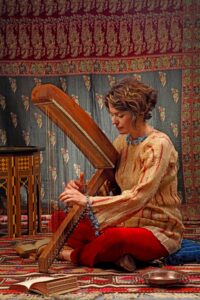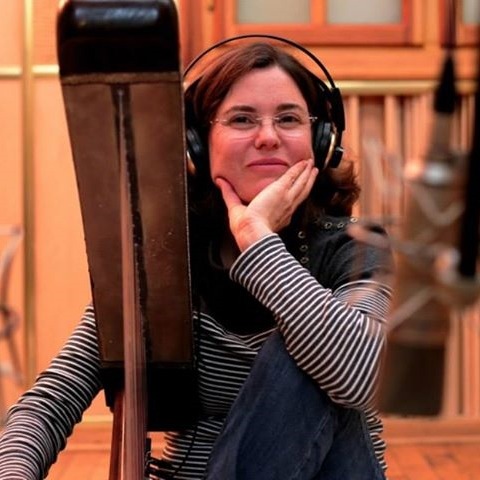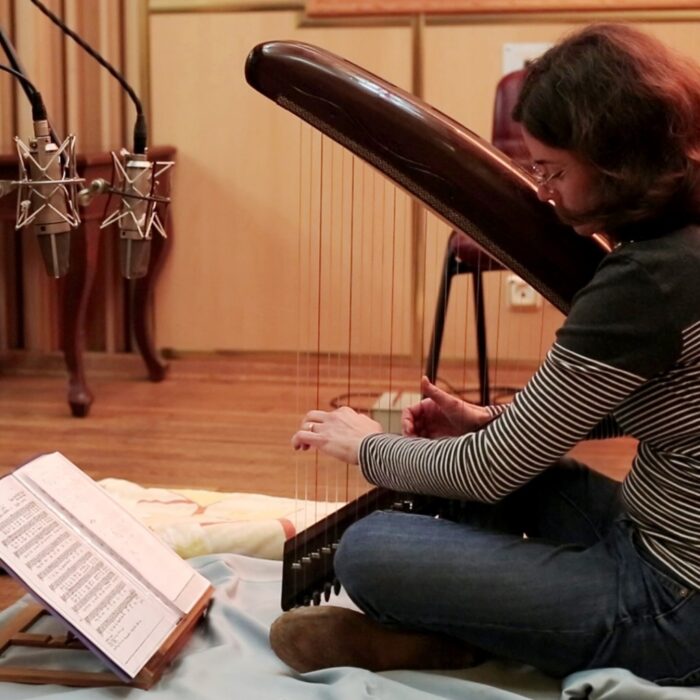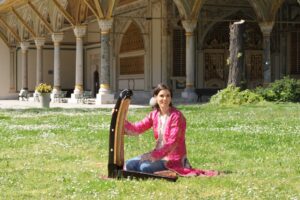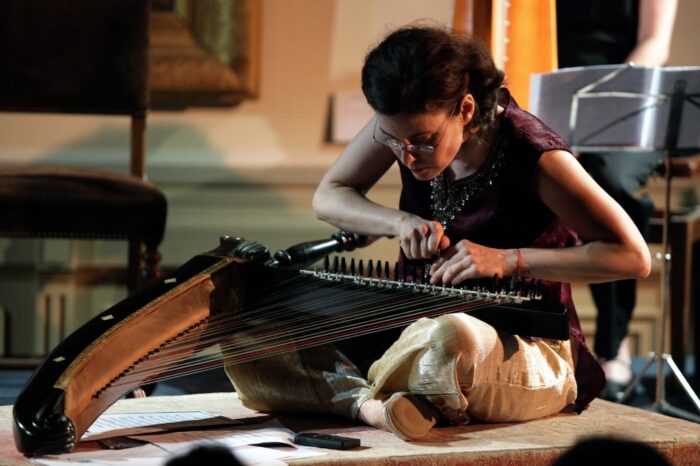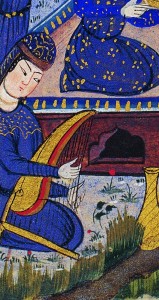
In the late 90’s, a harp represented in medieval and early modern Iranian and Ottoman miniatures caught my attention. It was a harp played sitting on the floor. That harp obviously belonged to the Anatolian geography I was born into. I realized that the very frequent depictions one could see of it in miniature paintings could be interpreted as a testimony of this instrument’s appeal in the Medieval period. However, my curiosity was limited to my imaginings as there were no surviving examples. One of the major figures of Turkish music, an ud player and composer, the late Cinuçen Tanrıkorur invited me to attend a concert of historical Turkish music at the end of the 90’s with him in Istanbul. There I saw a re-construction of a çeng.
The çeng is what we call an “angular harp”. It is a harp without a column, with strings streched between a rod and a body, held in such a way that the instrument rests on the rod. Such harps had been popular in Mesopotamia (going as far back as as 2000 BC) and after they had disappeared from there, they survived in the Islamic cultures of the Near-East. The çeng owes its characeristic sound mostly to the leather skin covering its soundbox. Played in the medieval courts, the çeng is often a symbol of political power, evoking a strong past. It also carries a mystic symbolism which is mostly due to its hunched back. A favorite theme among poets, the çeng however fell out of use gradually. In 1660 Evliya Çelebi noted in his famous travelogue that there was only one type of çeng and no more than ten players in Istanbul. This is the last written testimony we have of its existence.
Eight years after my first contact with the çeng, a desire grew in me to connect with traditional Turkish music culture as I was living in Turkey after nearly twenty years abroad. It was there; however, I had no knowledge. I was coming from an entirely western educational background and pursuing a performing and teaching career within that framework. So the çeng made it possible for me to connect. In 2007, I felt a strong motivation to pursue work towards rebuilding a çeng and proposing a musical environment fit for this instrument.
Building a Çeng
In 2007 I approached some instrument makers in Istanbul to build a çeng. The maker of the çeng I had seen in the late 90’s had refused to collaborate stating that he had made it for his personal use. Only a student agreed to build one. His teacher had some experience with historical instruments and had measurements for the overall design, but had not built a çeng. The instrument being obsolete, there was nothing to examine with the naked eye. We consulted music treatises from the medieval period and decided on the specifics of the design and materials. Funding was needed for the commission, so, I sent a project proposal to Tekfen Foundation who supported a symphony orchestra, which sometimes featured a traditional instrument. I designed the project so that not only would we build an instrument but also would include a commission for a concerto involving their orchestra and my çeng. It would include a premiere performance and a recording.
Here is a glimpse of the haunting sound of the çeng:
A çeng was built that presented many challenges to the performer. The wooden tuning pins would crack during tuning and get stuck in the holes. Different woods used in critical spots worked against each other. The tuning was very difficult. I had to learn to play this instrument with many shortcomings; as I was teaching myself how to hold it, I also had to figure out how to sit on the floor for extended amounts of time. The maker, I thought should go on and make an improved version but he had no interest. I had no other resources. A big event to showcase the çeng was planned and this was the war horse!
Creating Music for the Çeng
For the musical commission I chose Hasan Uçarsu, a prominent composer with whom I had collaborated on a few occasions. His output featured compositional elements grounded in traditional Turkish music. As the çeng was being built, a 30-minute concerto (entitled Uninvited Guests) was commissioned. We premiered the work, recorded and received massive press coverage. This project was completed in 2008.
Çeng no.2 and “Les Harpes du Sultan”:
Surely, more prototypes would be needed until a more dependable instrument would surface. On the other hand, I wanted to explore other ways to develop my repertoire; obviously I lacked performance practice knowledge of Turkish music, something that could be learnt only by way of aural transmission, it seemed. So I sought out another maker as well as performers with the highest command of this tradition who might be able to teach me. The realization that my knowledge of the most complicated harp scores did not help in any way when I took a look at a sheet of Turkish music was a big moment for me.
Much to my surprise none of the early players I connected with (all fantastic virtuosos of their instrument and with good command of the art of makam) taught me in the way I had expected. I think my only knowledge of learning was a thorough tutoring approach as I had experieced for nearly 30 years of my life. Our ensemble was made of a classical kemençe, ud, singer and percussion. The musicians offered some repertoire, which just about worked for putting on a concert program. Playing with this group of musicians was the only way at that time to keep learning, so I pursued what was available to me. A second çeng was made again with the support of the Tekfen Foundation, but it was not really better. Among other performance opportunities, our work resulted in a concert collaboration (Les Harpes du Sultan) with the French early music ensemble “Le Baroque Nomade”.
Our ensemble was made of a classical kemençe, ud, singer and percussion. The musicians offered some repertoire, which just about worked for putting on a concert program. Playing with this group of musicians was the only way at that time to keep learning, so I pursued what was available to me. A second çeng was made again with the support of the Tekfen Foundation, but it was not really better. Among other performance opportunities, our work resulted in a concert collaboration (Les Harpes du Sultan) with the French early music ensemble “Le Baroque Nomade”.
An electronic music context for the çeng
 In an attempt to expose the çeng in a variety of contexts, and absorbed by its sound aesthetics, I presented it to electronic music composer, Erdem Helvacioglu. In this collaboration we brought together the çeng, the pedal harp and the electro-harp with sound-sculpting electronica into one continuously evolving soundscape. I played the live harp, çeng and electro-harp parts, in addition to being involved in creating the sound bank Erdem used to compose his piece*. The aim of the collaboration was to expand the sonic possibilities of the “harp” through the use of extended techniques while blending contemporary experimental vocabulary with traditional elements. The otherworldy sound of the çeng became very discernable in contrast to a more complex sound universe through this work.
In an attempt to expose the çeng in a variety of contexts, and absorbed by its sound aesthetics, I presented it to electronic music composer, Erdem Helvacioglu. In this collaboration we brought together the çeng, the pedal harp and the electro-harp with sound-sculpting electronica into one continuously evolving soundscape. I played the live harp, çeng and electro-harp parts, in addition to being involved in creating the sound bank Erdem used to compose his piece*. The aim of the collaboration was to expand the sonic possibilities of the “harp” through the use of extended techniques while blending contemporary experimental vocabulary with traditional elements. The otherworldy sound of the çeng became very discernable in contrast to a more complex sound universe through this work.
https://erdemhelvacioglu.bandcamp.com/track/resonating-universes-part-2
Çeng no. 3 and “Çengnağme”
My involvement in Turkish music continued with the recording of the Çengnağme album which featured works from the early Ottoman repertoire and also new music with an “early music feel” to it. I learned how to accompany little hymns, how to embellish a melody, the little gestures helping to create depth and forward motion in the music; how to contribute to the music at hand when all players are actually looking at and playing from the same mono-staff piece of music. Since early music was not specific to a given instrument, there simply was one “tune” for each performer to expand on. I understood that not only was the music barebones, but also that the large body of what we call “Ottoman” or Turkish classical music, was actually not written down at the time it was created.
As I composed an instrumental suite* (saz semai) in the nikriz makam, I felt like I was stepping into an area of more complete musicianship. I got a taste of musical traditions where composing and performing are not separate specialty activities for a musician, but indispensable and interwoven with each other.
On the çeng building front, I kept working with instrument makers. The new çeng had metal tuning pins. This instrument held the tuning quite well and was more dependable from a performance point of view. In this phase of my informal (or I should rather say, non-institutional) studies of Turkish music, I fully realized that the çeng must have fit perfectly well in medieval music because it spoke so well in the more varied repertoire I started to perform from the Ottoman tradition. In miniature paintings (book illustrations, to be exact) where musical ensembles were depicted, there was almost always a çeng, a ney and percussion. Sometimes a kemençe or a string instrument belonging to the family of lutes would appear. But the ensemble h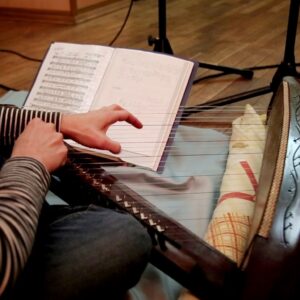 ardly ever exceeded a trio.
ardly ever exceeded a trio.
Once the new çeng was ready, I decided to do a collaborative recording to demonstrate the possibilities of the little harp next to its traditional “friends”, such as the tanbur, the ney, the kemençe, percussion and some vocals. We released “Çengnağme” (The Song of the Çeng) and started performing in various venues in Turkey and abroad, usually as a trio.
Çeng no. 4
In 2016, after having gone through three çeng prototypes, and having no.3 structurally break down, I have come across a Scottish harp builder who specialized in historical and traditional (European) harps with extensive experience. Graham Muir from Ardival Harps took interest in making a çeng, which was a first for him. He solved the structural problems of the first three and used wonderful strings which resulted in good sound.
I still feel the overall design can be improved ergonomically. For sure, there is need to build further and play more. The exchange of knowledge and feedback between an instrument maker and player had not been something I experienced in the pedal harp world where the player chooses an instrument built in a factory and usually that’s it. But here, nothing can happen without being a team. The making can only progress through adventurous performing. A real connection between a maker and performer is needed to “create” the instrument.



